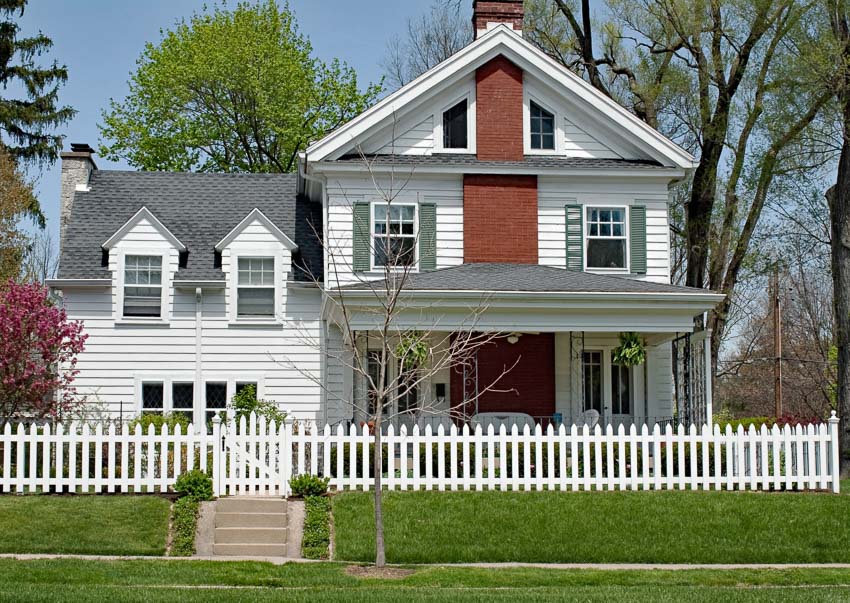The Ultimate Guide to These Attractive, Durable Fences
Homeowners today have several good choices when it comes to high-quality fencing materials. People often choose vinyl because it’s low-maintenance and has a modern appearance. It’s a long-lasting fence material that won’t rot or succumb to insects, and it’s the perfect solution for homes in coastal regions and high-humidity areas. Learn more about vinyl fencing advantages, styles, and costs to help you choose the best type of fence for your home.
What is a Vinyl Fence? A Contemporary and Low-Maintenance Option
Vinyl fences are made of polyvinyl chloride (PVC), and they have become increasingly popular because they are durable and low maintenance. Vinyl is an excellent alternative to wood because it resists decay, insects, and UV rays.
Its rising popularity is also due to the fact that it comes in a wide range of colors and styles.
The Basics of Vinyl Fencing
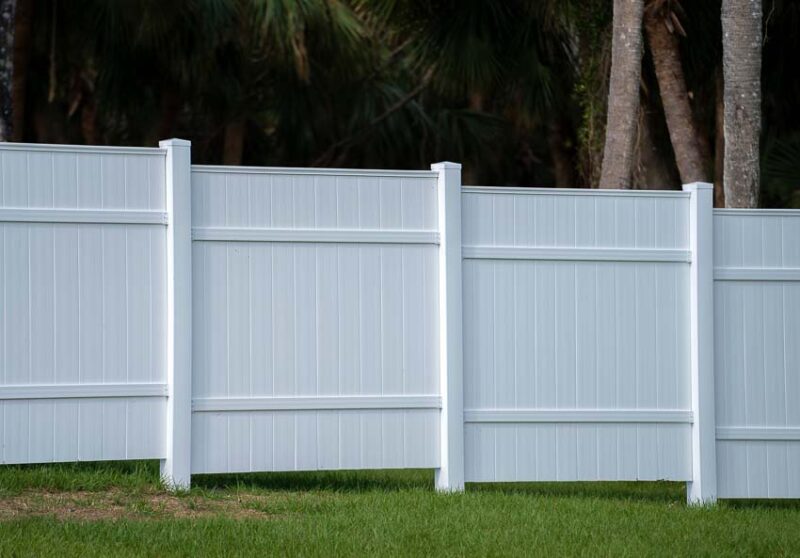
PVC has been around since the 1950s, but it wasn’t until the 1970s that manufacturers started using it to make vinyl fences. Originally, they were shiny and white, and the only design was a ranch-style rail fence.
There are thousands of vinyl fencing options in every color, texture, style, and shape.
Key Components and Materials: PVC and Beyond
You can purchase vinyl fences as prefabricated panels or board and rail systems. They can come preassembled or packaged in separate pieces that need to be assembled.
No matter what type you purchase, though, it will consist of key components like posts, sections, and gates.
| Vinyl fence component | Purpose |
| End posts | Used at the end of a fence run |
| Corner posts | Used where fences make a 90-degree corner |
| Line posts | Support the sections of fence panels or rails, spacing is determined by the length of the fence sections |
| Gate posts | Sturdy posts used to support a gate |
| Blank posts | Used on the non-hinged side of a gate |
| Post caps | Decorative caps for posts |
| Post skirts | Decorative bases for posts |
| Vinyl fence sections or panels | Come in a variety of fence styles |
| Vinyl fence rails | Top, middle, and bottom fence rails |
| Vinyl fence mounting accessories | Including all vinyl fence hardware, such as mounting brackets, fence clips, glue, screws, and screw caps |
| Gates | Usually installed as single or double gates, come in a wide range of sizes, styles, colors, and textures |
| Gate hardware and accessories | Includes all hardware and fittings for gates, like nylon gate hardware and gate frame components |
Popular Vinyl Fence Styles and Designs
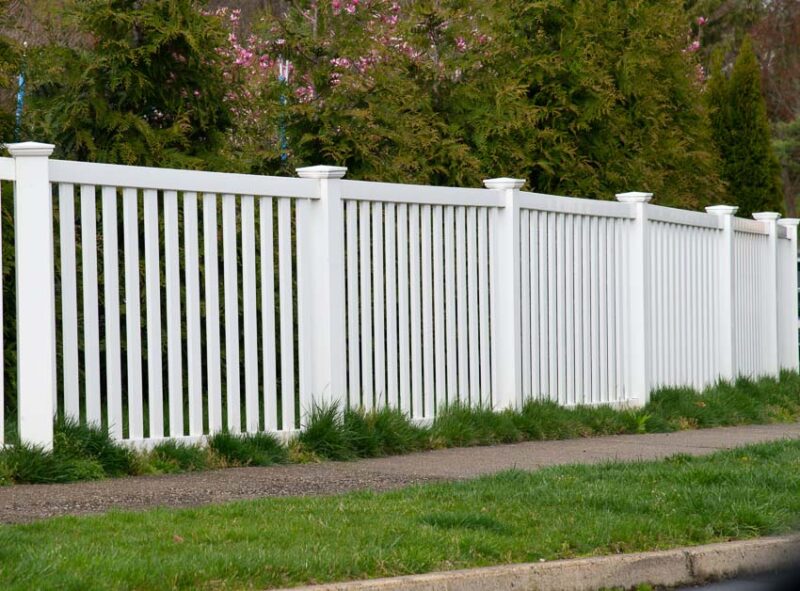
When companies prefabricate these fences, you can’t customize them like wood fences. However, there are so many styles to choose from that you still have plenty of options. It won’t be hard to find a style to enhance your home’s curb appeal.
Here are the most common styles of fence panels and rail systems available:
| Vinyl fence style | Features |
| Vinyl privacy fence | Usually built with panels that are 6’ to 8’ long, can be paired with a variety of decorative tops |
| Semi-privacy vinyl fences | Provide privacy while still letting air flow through, available in several different designs, including shadowbox and louvered fences |
| Vinyl lattice fence | Thin lattice slats are a cost-effective choice, provide some privacy, and are excellent for plant trellises |
| Vinyl picket fence | Available in flat top and scalloped picket fence styles, made to replicate traditional white picket fences |
| Vinyl post and rail fence | Can have 2, 3, or 4 rails, also include cross-buck styles, great for agricultural, livestock, and boundary fences |
| Horizontal vinyl fence | Private and semi-private fences made with horizontal rails placed between two posts |
In addition to the above styles, you can customize vinyl fences by selecting a custom height and adding a variety of features, including post caps, finials, and post skirts. You can choose between many different colors, including white, black, tan, gray, and multi-toned fences.
Cost Factors and Pricing
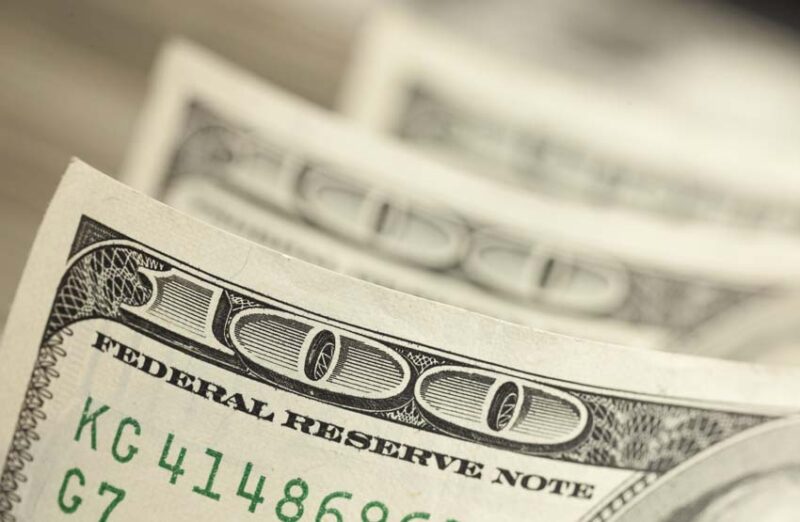
The average cost is $15 to $40 per linear foot, and most people pay between $2,200 and $6,000 to install a vinyl fence. The national average is $4,100, but the actual cost of your vinyl fence will depend on several factors.
Since vinyl fencing is a prefabricated product, it’s easier to calculate your project’s estimated cost, and fewer factors can influence the cost. There are fewer surprises when installing vinyl fencing since there are fewer ways to customize it.
When you’re installing a vinyl fence, it’s important to consider materials, labor, and add-on features so you can stay on budget.
Material and Production Costs
The cost of materials is $10 to $30 per linear foot, not including installation. Vinyl fencing is more expensive than other types of fencing, mostly due to the cost of materials.
High-end materials are long-lasting and durable and can look great for 20 to 30 years with very little maintenance. If you choose low-end vinyl fence materials, they will crack, dent, and warp, and you’ll end up with higher maintenance costs.
Here are the factors that influence the cost of materials associated with vinyl fencing:
- Size of your yard
- Height
- Complexity of design
- Thickness and quality of vinyl
- Texture
- Regional supply and demand
Installation Costs and Labor Considerations
The average cost for labor and installation is $5 to $10 per linear foot. Vinyl fences are easier to install than many other fences, especially when preassembled.
Installing these fences costs are influenced by typical factors that affect many other types of fence installation, meaning you won’t necessarily save a lot of money by choosing a different type of fence.
Here are the factors that affect labor and installation costs:
- Size of your fence, including length and height
- The spacing of fence posts
- The layout of your fence
- Soil conditions
- The terrain
- The regional labor market
- Landscaping obstructions that could require tree, shrub, or stump removal
- Grading or leveling the ground
Customization and Decorative Elements
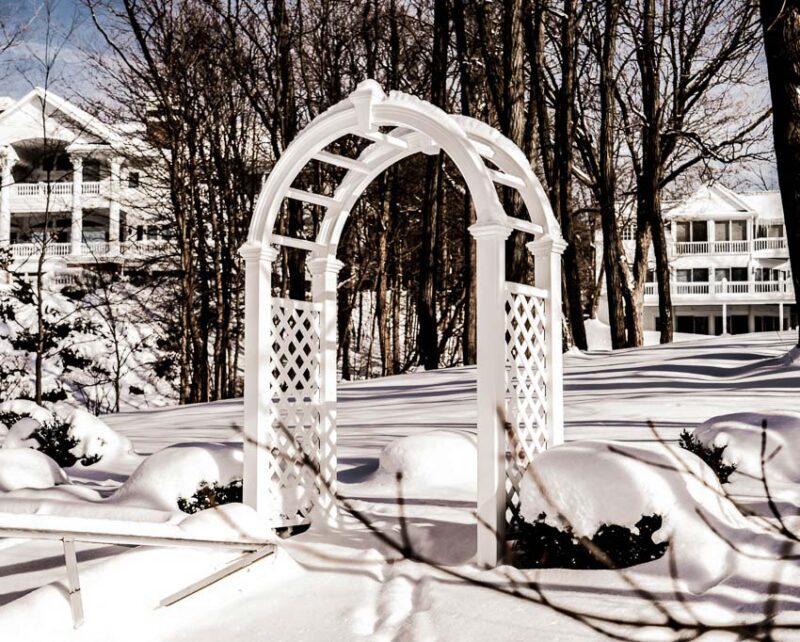
There is a wide range of prefabricated panels that have built-in design elements like lattice toppers and scalloped designs. Choosing a style with these design elements is a great way to get started on a custom vinyl fence.
Here are other ways to decorate your fence to make it more unique and attractive:
- Add decorative post caps, finials, and post skirts
- Use over the panel hooks to hang outdoor art, planters, macrame, yard tools, or LED lights.
- Solar LED lights are available in hundreds of styles, and you can use them to accent decorative elements on your fence.
- Solar LED post caps are a great way to light up your yard to make it safer.
- Mount corner shelving for potted plants.
- Use rail planters to add flowers and greenery to posts and rail fences.
- Install a trellis about 12 inches in front of your vinyl fence and plant climbing vines, roses, and ivy.
- Have a custom gate installed.
Maintenance and Repair Expenses
Vinyl fences don’t require a lot of maintenance, but they could require extensive repairs as they age. Sometimes, it’s less expensive to purchase a new panel or post than it is to repair it.
Here are the most common maintenance and repair expenses that homeowners pay for when they own a vinyl fence:
- Pressure washing, typically costs $180 to $400
- Gate repairs, from $260 to $525
- Painting to give your fence a facelift, $1,700
- Fence post replacement, $60 to $110 per post
Other maintenance tasks include repairing or replacing pickets, rails, and panels. You can either DIY fence repairs or hire a general handyman at $25 to $35 per hour to save money.
If you hire a professional fence installer, it will cost you twice that amount.
Why Choose Vinyl Fencing Over Other Options?
Vinyl fence is an attractive fencing material, and since it’s easy to care for and lasts a long time, it can save you money compared to high-maintenance fences like wood. If you’re still trying to decide if this fencing is the best choice, take a closer look at the many benefits to help you decide.
Low-Maintenance and Durability
Manufacturers build these fences to last, and with a 20-year warranty, it’s a great investment compared to other types of fences. Without having to worry about fence maintenance, you can focus your yard care efforts on your lawn and garden to make your home even more comfortable and appealing to your family and guests.
Wide Range of Styles and Colors
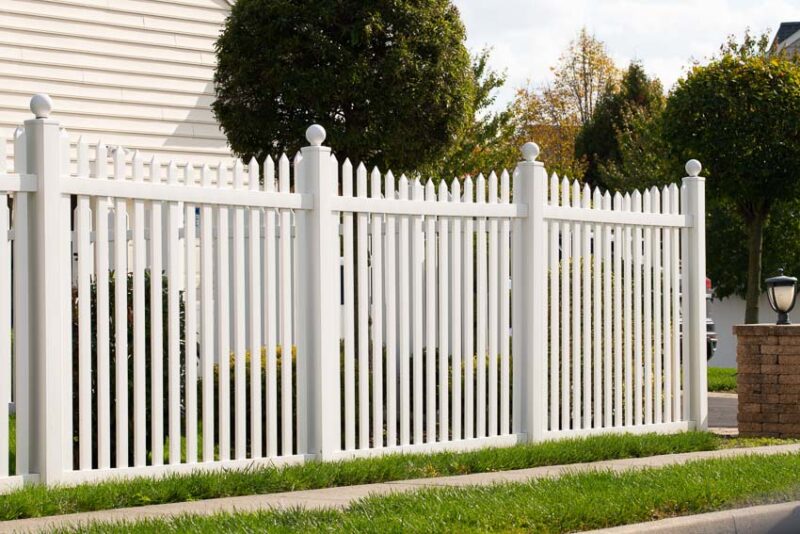
Vinyl fencing has come a long way since it first appeared in the 1970s. Today, it comes in various colors, textures, and styles. Even though it’s not as customizable as other fence types, it offers so many attractive styles that it can be difficult to choose.
Enhanced Privacy and Security
Vinyl privacy fences are among the best choices for making your home more private and secure. They are also excellent choices for noise buffering, so you often see them installed along property lines that are close to busy roads.
Long-Term Value and Investment
Vinyl fences are valuable to your property, and because they don’t require extensive maintenance, they won’t keep costing you year after year. Some fence types add little value to your property, but vinyl fences often add to your home’s marketability, making it sell faster.
Because you don’t have to replace these fences as often as others, they’re considered sustainable even though vinyl isn’t necessarily eco-friendly. If your fence has reached the end of its lifespan, you might be able to bring it back to life by painting it.
Manufacturers can also recycle it into new vinyl fence products.
Frequently Asked Questions About Vinyl Fencing
How much does a vinyl fence typically cost?
Nationally, the average cost is $4,100, and most people pay between $2,200 and $6,000 to have it installed. If you choose to install it yourself, you can save about $5 to $10 per linear foot, but since most of the cost is materials, it may be worth it to pay a little extra for a professional installation, especially if it is required for your warranty to be valid.
What are the main differences between vinyl and other fencing materials?
Vinyl is extremely durable and long-lasting compared to other types of materials. Vinyl requires almost no maintenance other than regular cleaning, unlike wood, which needs to be repainted or restained every few years.
It is one of the best choices for privacy fences because it absorbs sound and creates a wall between you and your neighbors.
How do I maintain and protect my fence from damage?
Vinyl is resilient and requires very little care. One of the most significant preventable problems is mold or mildew. Cleaning with mild detergent, warm water, and a gentle brush is easy.
Perform regular inspections and keep trees and shrubs near your fence pruned to prevent damage. Accidents cause the most damage–things like vehicle collisions and falling trees, which can’t always be avoided.
Can they be customized to match my property’s style?
Vinyl is not easily customized, but it’s easy to choose a style, height, color, and texture that enhances your home’s curb appeal. Add-on features like post caps and skirts can help you create a unique style for your fence that matches the style of your property.
What is the average lifespan of a vinyl fence?
They usually last about 20 to 30 years, and many brands have 20-year warranties.
Better quality materials cost more upfront but may last up to 10 or 15 years longer than inferior products. Because low-quality vinyl tends to warp, crack, and split, choosing a good-quality vinyl fence is usually more cost-effective in the long run.

